May 2, 2024
Waste brings new life through composting: Sustainable practices after Earth Day Run
By Dorothy Castro
The successful Galaxy Watch Earth Day Run by Runrio on April 21 at SM Mall of Asia concert grounds included sustainable initiatives from Tzu Chi volunteers who recycled 242 kilograms of banana peels collected from the run. This material became a great addition to the composting practice at Buddhist Tzu Chi Campus (BTCC) in Sta. Mesa, Manila, where eggplant, okra, cabbage, and calabash are grown and used as ingredients for vegetarian dishes.
Plant enthusiast and Tzu Chi volunteer Hilario Velasquez, applied his knowledge on composting to BTCC’s garden by using food waste such as fruit and vegetable peels. “I also do this at home. I enjoy taking care of plants. Hence, I tried composting at a larger scale,” Velasquez said. The composting garden at BTCC features many plants growing healthily with the aid of natural fertilizers.
What makes composting an easy and cost-friendly process is the variety of options to use alongside garden soil. For example, fruit peels from an afternoon snack can be easily set aside for later use.
“Here at Tzu Chi, we have plenty of grass, leaves, fruit and vegetable peels, and rotting vegetables. In fact, we can even use eggshells and papers such as old newspapers when composting,” Velasquez added. He noted that they avoid using other food items that may attract insects and pests.
It takes very few materials to start composting. Apart from organic materials like fruit and vegetable peels and garden soil, Velasquez recommends using a large drum container. This is because the process mainly involves layering the garden soil and organic material into the container and storing it for three to four months.
With the composting process, it is also important to watch out for pests. This can be avoided by keeping the containers covered. “This is to ensure that our composting drum does not emit a strong, unpleasant scent that can attract pests,” he explained. Mixing the compost every three days ensures that the organic material and garden soil are well incorporated.
The composting process is completed after the batch of compost is brought out to dry under the sun and strained to remove any clumps from the batch. The result is a healthy and organic fertilizer that can be added to one’s home garden.
Volunteers who have been composting regularly in BTCC, recently completing the third batch of compost for the garden. “I believe it is better that our vegetables are grown with natural fertilizers from compost, because this means we do not use any unwanted chemicals,” said Velasquez.
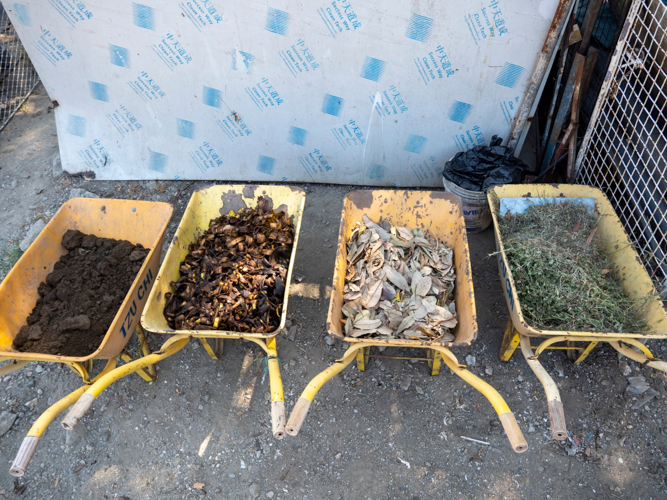 Banana peels, leaves, and other plant cuttings were collected for this batch of composting, along with the garden soil. 【Photo by Matt Serrano】
Banana peels, leaves, and other plant cuttings were collected for this batch of composting, along with the garden soil. 【Photo by Matt Serrano】
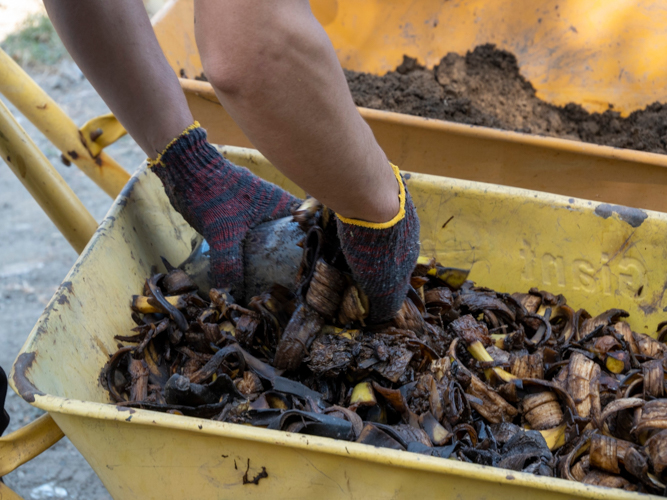 The banana peels collected from Runrio’s Galaxy Watch Earth Day Run on April 21 were used for composting. 【Photo by Matt Serrano】
The banana peels collected from Runrio’s Galaxy Watch Earth Day Run on April 21 were used for composting. 【Photo by Matt Serrano】
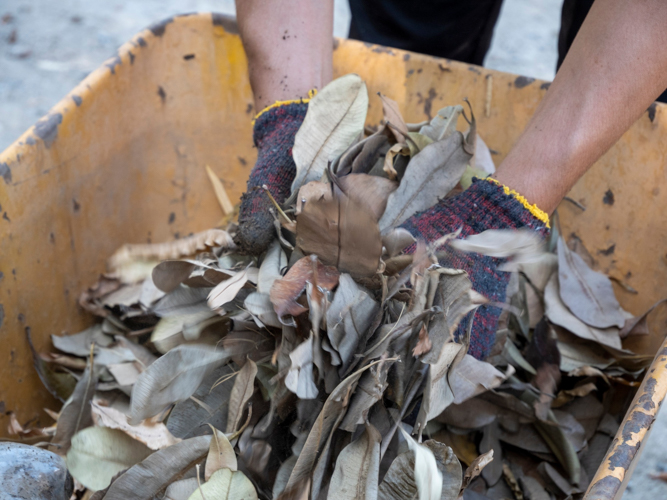 As there are many plants in Buddhist Tzu Chi Campus (BTCC), the abundance of fallen leaves makes a great addition to the compost materials. 【Photo by Matt Serrano】
As there are many plants in Buddhist Tzu Chi Campus (BTCC), the abundance of fallen leaves makes a great addition to the compost materials. 【Photo by Matt Serrano】
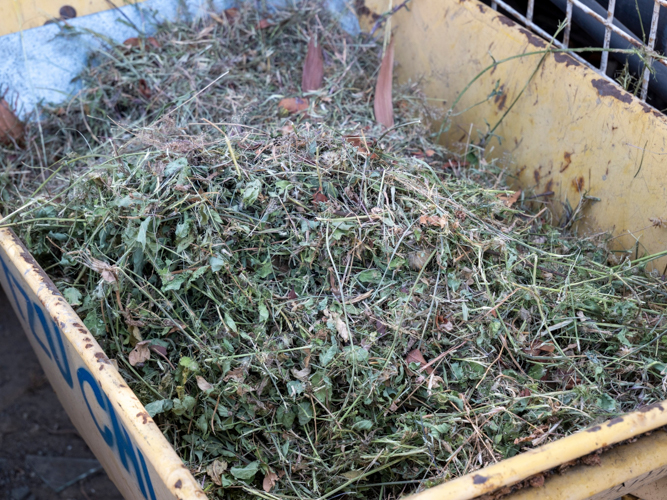 Other plant cuttings and smaller leaves were also put together to add to the compost batch. 【Photo by Matt Serrano】
Other plant cuttings and smaller leaves were also put together to add to the compost batch. 【Photo by Matt Serrano】
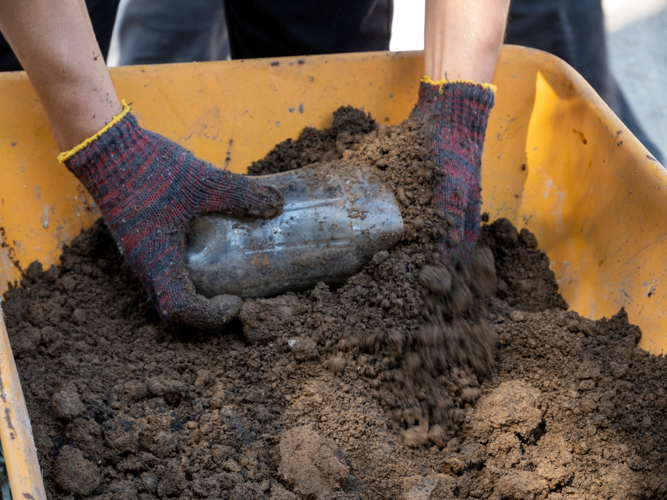 Hilario Velasquez, a Tzu Chi volunteer, recommends the use of garden soil for composting. 【Photo by Matt Serrano】
Hilario Velasquez, a Tzu Chi volunteer, recommends the use of garden soil for composting. 【Photo by Matt Serrano】
 The composting materials were then brought together and placed into the drum container, where around one to two inches of garden soil and organic materials are layered. 【Photo by Matt Serrano】
The composting materials were then brought together and placed into the drum container, where around one to two inches of garden soil and organic materials are layered. 【Photo by Matt Serrano】
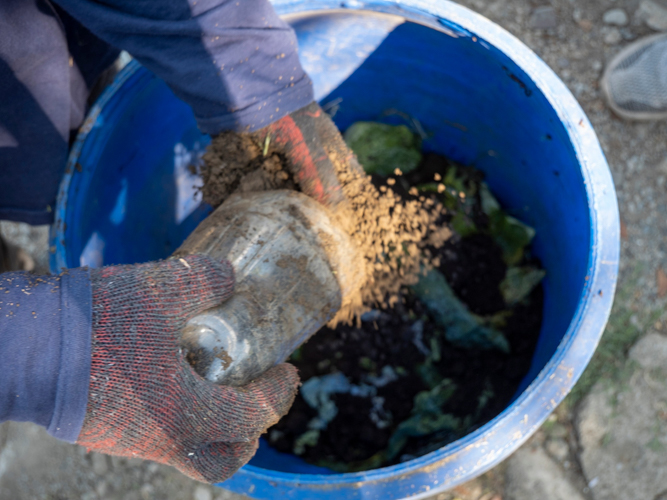 The process of composting includes layering the soil as well as the fruit and vegetable peels continuously, leaving only about five inches of space from the top of the container. 【Photo by Matt Serrano】
The process of composting includes layering the soil as well as the fruit and vegetable peels continuously, leaving only about five inches of space from the top of the container. 【Photo by Matt Serrano】
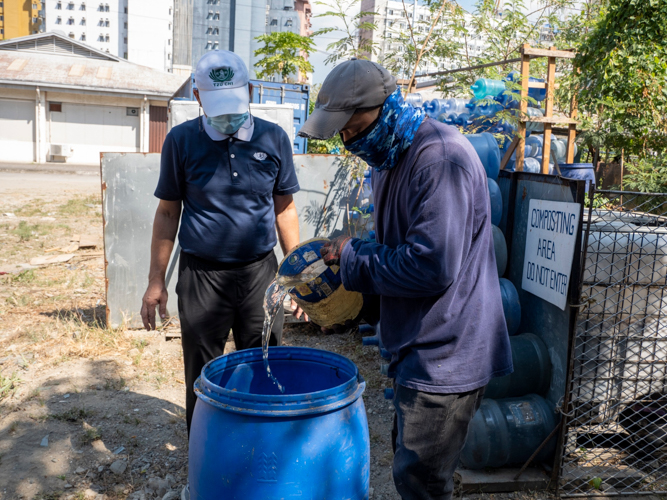 A generous amount of water is poured onto newly prepared compost drums to help prevent crumbling compost. 【Photo by Matt Serrano】
A generous amount of water is poured onto newly prepared compost drums to help prevent crumbling compost. 【Photo by Matt Serrano】
 Covering the compost container, as Hilario Velasquez reminded, is a crucial step in preventing insects and pests from going into the compost. 【Photo by Matt Serrano】
Covering the compost container, as Hilario Velasquez reminded, is a crucial step in preventing insects and pests from going into the compost. 【Photo by Matt Serrano】
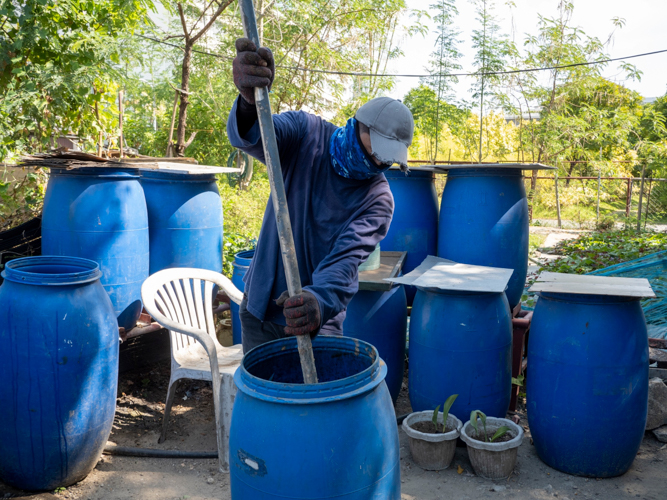 By stirring the compost every three days, the fruit and vegetable peelings are well incorporated with the garden soil. 【Photo by Matt Serrano】
By stirring the compost every three days, the fruit and vegetable peelings are well incorporated with the garden soil. 【Photo by Matt Serrano】
 The banana peels are now well incorporated with the garden soil, and ready to be stored for three to four months for the decomposition to take place. 【Photo by Matt Serrano】
The banana peels are now well incorporated with the garden soil, and ready to be stored for three to four months for the decomposition to take place. 【Photo by Matt Serrano】
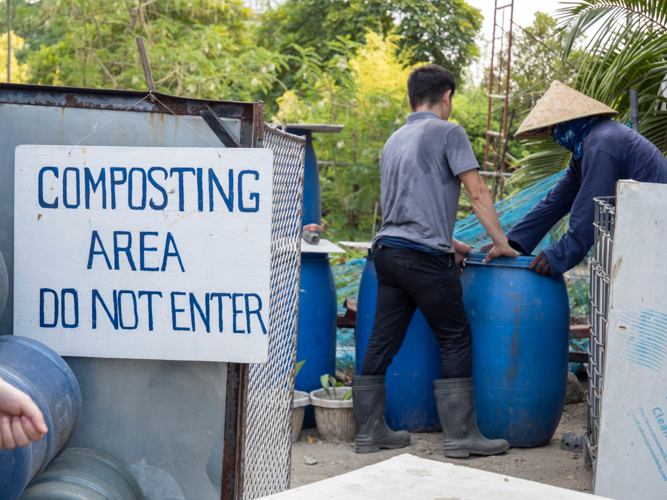 After three to four months, batches of compost are brought out to be used for new plants at BTCC. 【Photo by Matt Serrano】
After three to four months, batches of compost are brought out to be used for new plants at BTCC. 【Photo by Matt Serrano】
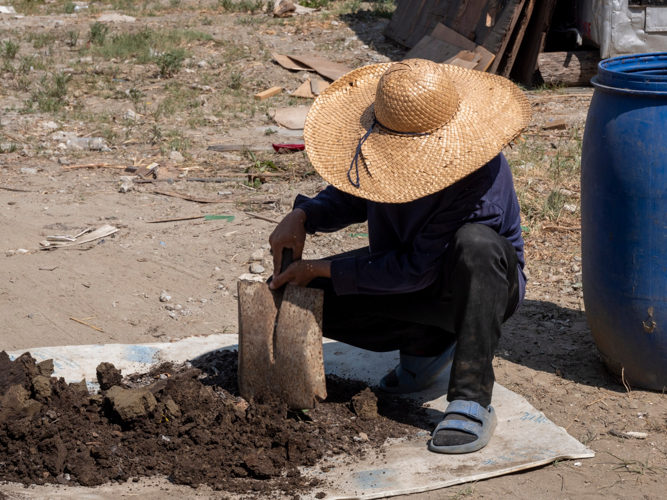 The gardener carefully lays out the composting soil under the sun. 【Photo by Matt Serrano】
The gardener carefully lays out the composting soil under the sun. 【Photo by Matt Serrano】
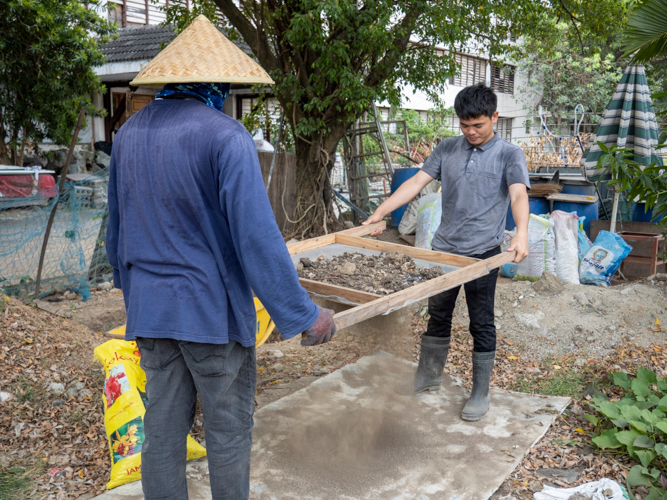 The batch of composting soil is then strained to remove clumps. 【Photo by Matt Serrano】
The batch of composting soil is then strained to remove clumps. 【Photo by Matt Serrano】
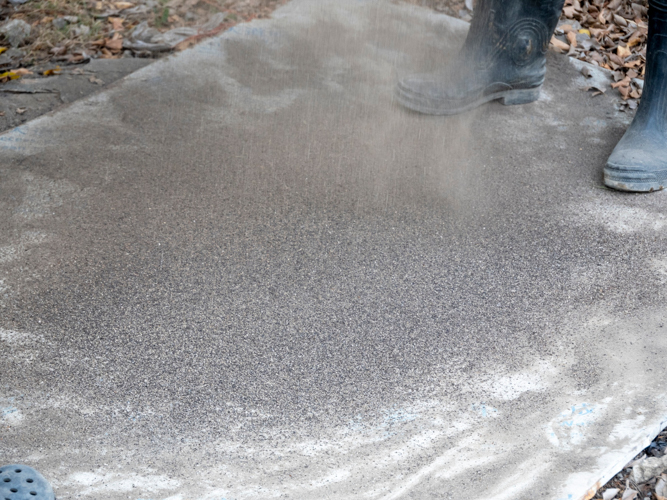 According to Hilario Velasquez, the finished product for composting can now be used as a natural fertilizer for plants. 【Photo by Matt Serrano】
According to Hilario Velasquez, the finished product for composting can now be used as a natural fertilizer for plants. 【Photo by Matt Serrano】
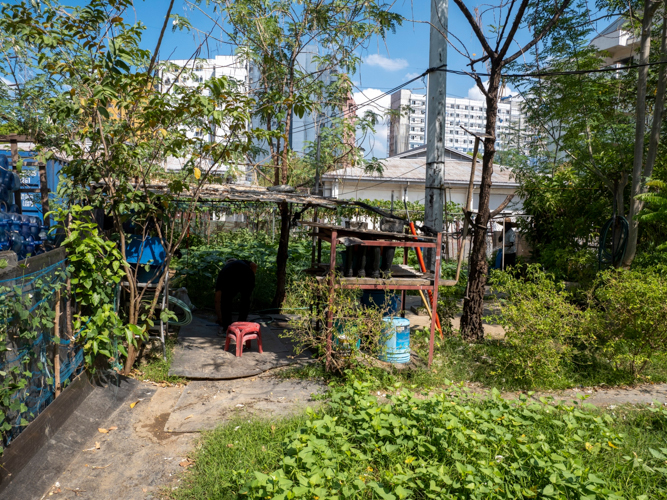 The composting garden at BTCC in Sta. Mesa Manila houses a variety of decorative plants and nutritious vegetables. 【Photo by Matt Serrano】
The composting garden at BTCC in Sta. Mesa Manila houses a variety of decorative plants and nutritious vegetables. 【Photo by Matt Serrano】
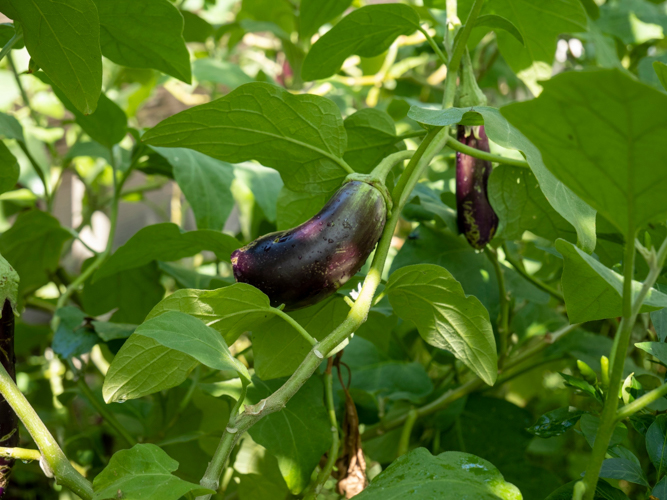 Among the many crops planted in the composting garden, vegetables are healthily grown using the compost prepared by BTCC gardening staff. 【Photo by Matt Serrano】
Among the many crops planted in the composting garden, vegetables are healthily grown using the compost prepared by BTCC gardening staff. 【Photo by Matt Serrano】
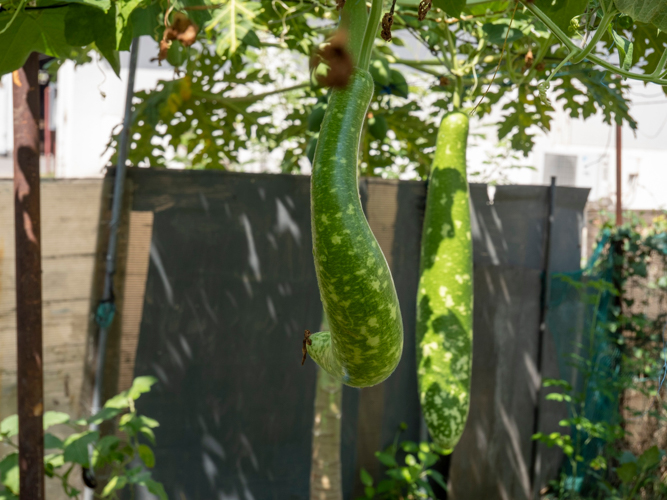 Among the many crops planted in the composting garden, vegetables are healthily grown using the compost prepared by BTCC gardening staff. 【Photo by Matt Serrano】
Among the many crops planted in the composting garden, vegetables are healthily grown using the compost prepared by BTCC gardening staff. 【Photo by Matt Serrano】
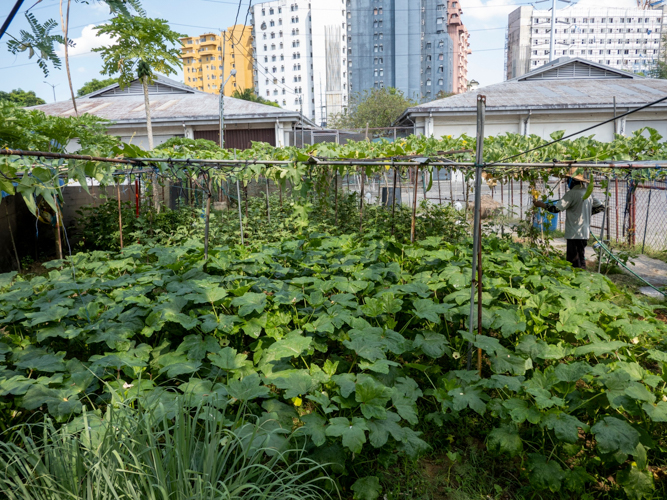 Aside from nutritious vegetables, BTCC’s garden also grows decorative plants.【Photo by Matt Serrano】
Aside from nutritious vegetables, BTCC’s garden also grows decorative plants.【Photo by Matt Serrano】
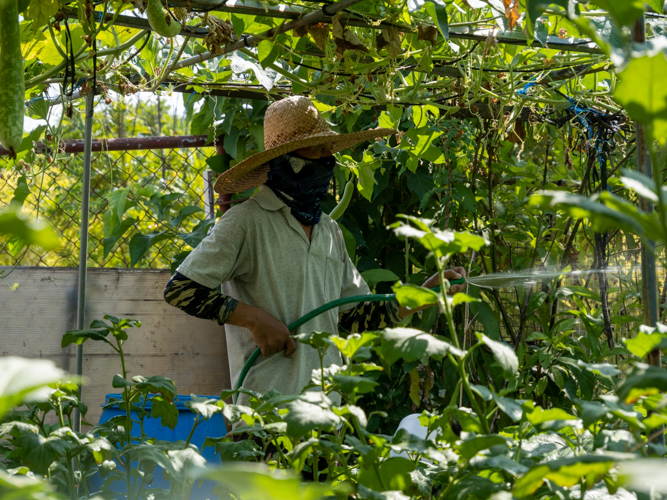 Gardeners regularly water the plants every morning to prevent them from drying out as temperatures increase. 【Photo by Matt Serrano】
Gardeners regularly water the plants every morning to prevent them from drying out as temperatures increase. 【Photo by Matt Serrano】





